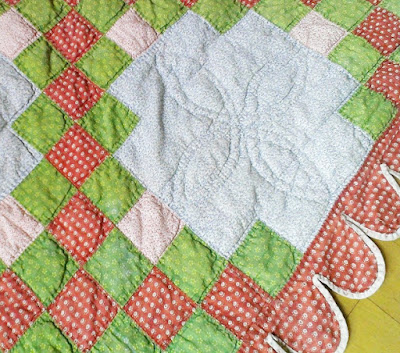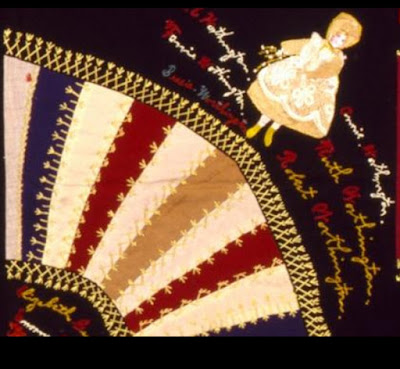Green calicoes are hard to date but here's a classic star to help us out. It's signed "Clara 1906," maybe a little later than I'd have guessed although one observation is, "The pinker the quilt the closer to 1900 it is."
Sorting through my pictures of dated quilts from about that time
I find many with these green calico florals including two Double Irish Chains
dated 1893.
"J.D.M. Louwers 1894"
Another star. It would seem these old-fashioned quilts in old-fashioned red and green
come from quilters in southeastern Pennsylvania's German Anabaptist sects.
"1906 Shirk"
Fabric vendors must have catered to their tastes and perhaps the mills did too.
Collection of Michigan State University
One mill that marketed a line of traditional calicoes was the S.H. Greene Company
of Riverpoint, Rhode Island in the area of Warwick.
Bolt Label from the Library Company of Philadelphia
S.H. Greene & Sons was founded in 1865 by a family who'd been in the fabric business in Rhode Island since the 18th century. Simon H. Greene founded the Clyde Bleachery & Print Works in 1828. At first they focused on indigo prints but as the century wore on expanded to a variety of specialties, including Turkey reds, kerchiefs and bandanas and these small-scale florals, which they marketed as Washington Prints.
One of their plain bleached cottons, the lining to Emily
Hollingsworth's 1835 silk dress.
A 1908 statistic: They continued to bleach cotton, producing one and a half million yards a week and printing one and a quarter million yards of that.
Turkey red bandanas at the end of the century, also branded
as Martha Washington
Bolt Label from the Library Company of Philadelphia
They printed many traditional cotton calicoes around the same time, the kinds of prints advertised in the 1898 Montgomery Ward's catalog as "Oil prints, green ground, yellow and black small figures; canary with red and black small figure; red ground with yellow and black figure."
And Turkey red robe prints, for comforters
1888 ad in the Omaha Bee
"oil-boiled" refers to the old Turkey red process.



































































